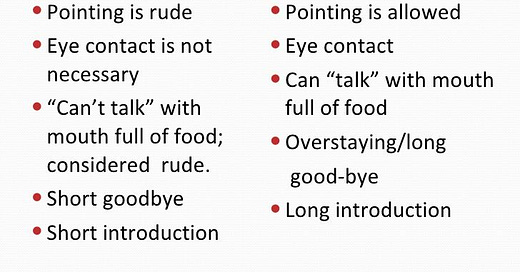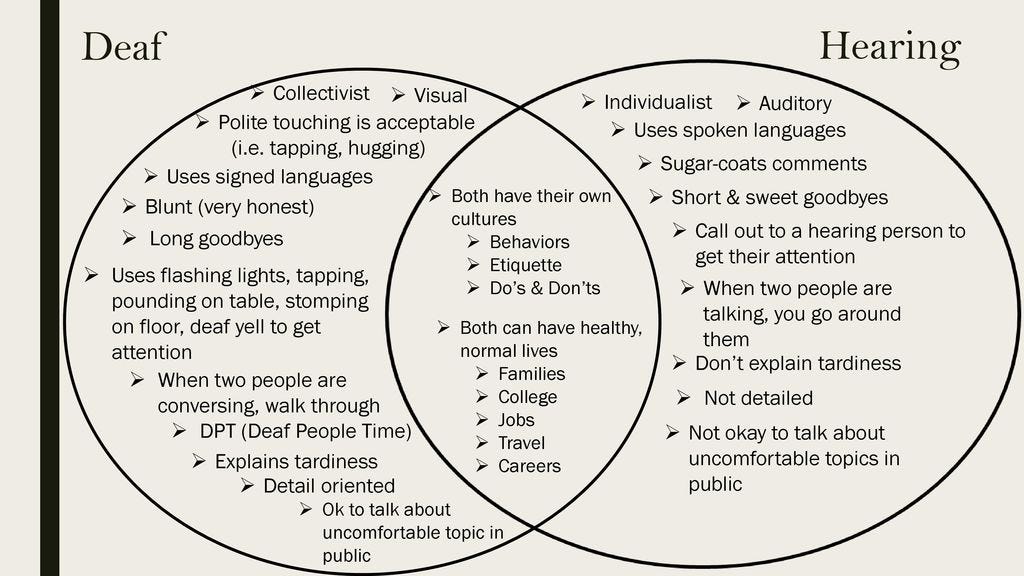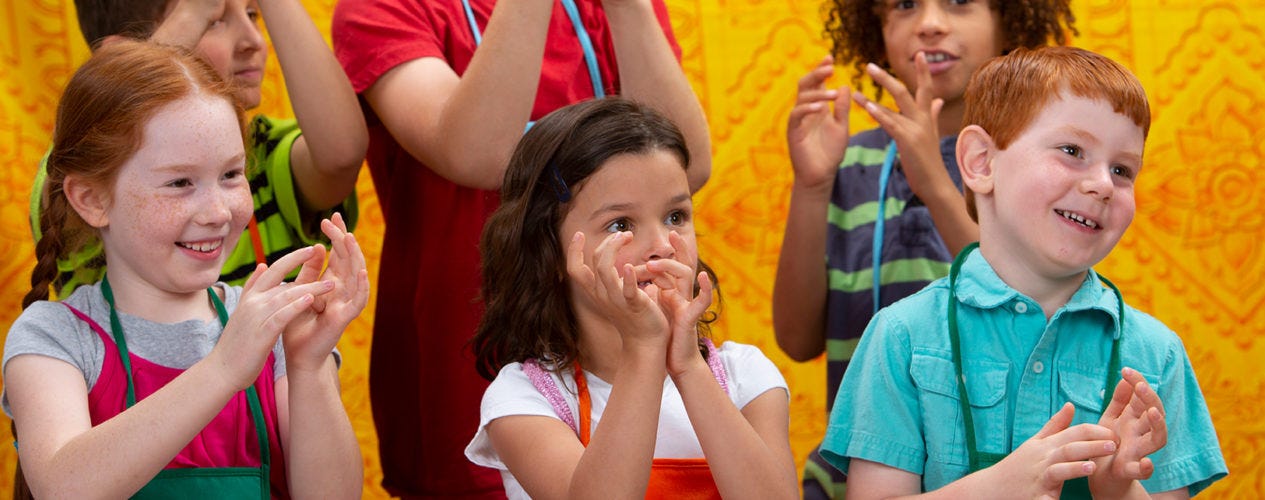Deaf Culture
I. Introduction
In this post we shall continue to learn about the Deaf and what is known as the “Deaf Community.”
II. Frame Work
As a frame work to understanding the Deaf Community, think of the Deaf Community as a fox hole with soldiers of the U.S. fighting a foreign enemy. Those in the fox hole may have different ages, races, genders, religions and beliefs. However, they have one thing in common. They consider themselves to be Deaf and they are besieged by a group who does not understand them or communicate well with them. Just as soldiers in a fox hole subordinate their individual beliefs to fight against a common enemy, the deaf who are in fox hole are forgiving of their mutual differences in the face of a common goal which is the acceptance and understanding of themselves as people and a culture. The commonality of deafness overrides many of their individual particular beliefs. Instead they know the brotherhood and sisterhood of a common bond and have a common experience in dealing with a world which is often hostile and non-accepting.
The second framework to facilitate an understanding of the Deaf Community is to think of the Deaf Community as its own country. The community has its own official language which is sign language (the “official” language is ASL). Other sign languages are allowed, but they are not the official language of our fictional country. To be a member of the country you need to think of yourself as being a part of the Deaf Community. You spend time with others in the community. You have common interests. In addition, you have common customs. You have a deaf identity.
III. The Deaf Community
Below, I discuss some of the characteristics of the Deaf community in the United States. Some of the characteristics of the Deaf Community and Culture include a sharing of sign language, the identification with the Deaf Culture and a sharing of its values. The Deaf know that they are deaf. The Deaf share the values of the Deaf and they are proud of their unique heritage and culture. They are unapologetic (and neither should they be) and are “deaf proud.”
Common Language
Although we have spent a substantial amount of time discussing sign language, the proficient use of sign language is a factor which easily identifies you as a member of the Deaf Community. Non-proficient attempts at sign language identify you as someone who is interested in the Deaf but only when you become proficient in its use do you pass one of the significant barriers to entering the Community. Inefficient or plebian attempts at sign may suggest that you are not an ignoramus; however the rudimentary use of sign is somewhat like me trying out my second year French in Paris. They know that I am trying but they also know clearly that I am NOT French.
Expertise in sign language can be a passport into the country of the Deaf. Interestingly, there are many people who are functionally deaf who are not really thought of as being the “Deaf” (with a capital “D”) and who are not included in the “Deaf Community” or “Deaf Culture.” A great number of people have been hearing most of their lives and began to experience different degrees of deafness as they age. They are often known as the “late-deafened.” They generally do not sign and often benefit from technologies such as real-time captioning. These individuals in most cases do not learn identify with the deaf culture even though their hearing is diminished or even non-existent. Practically speaking, most of them do not consider themselves part of the Deaf Community. Neither does the Deaf Community identify with them. They are the “forgotten deaf”. They do not speak the language. They do not have the sign passport and they are not members of “deaf country.”
Most churches when they begin a deaf ministry think of a ministry to those in the Deaf Culture as opposed to a group which may be even larger in their church which are the elderly, non-signing deaf. For instance, many elderly who are members of larger churches try to watch church services on television being unable to leave their homes or nursing homes for reasons of mobility or other reasons. The majority of these churches could have their services equipped with captions for television; however they do not. The elderly who are deaf and who do not sign are overlooked.
One of the problems which churches have in reaching out to the deaf is that they have wonderful well-intentioned people who have learned sign who make an effort but they frankly are not proficient in sign. They can make themselves known but it is not their “native language.” A “sign ministry” is not enough.
There are numerous other characteristics of the Deaf Community which are discussed below.
Deaf Schools and Deaf Education
Deaf schools and Deaf Education play a significant role in Deaf Culture. The majority of children born deaf are born to hearing parents. When they are mainstreamed into non-deaf culture, they take on the characteristics of that non-deaf culture. However, many of the deaf children born to both hearing parents and non-hearing parents spend time in deaf schools many of which are residential. When the children spend time in deaf schools they pick up the characteristics which are distinctive of Deaf Culture. For that reason, deaf schools play a great role in inculcating and developing Deaf Culture. From the standpoint of evangelization of the deaf community the use of deaf school and campus ministries would have more significance and effectiveness than hearing campus ministries in a mainstreaming environment.
One commentator has said that residential deaf schools are the “root of the Deaf Community.” The Deaf attending these schools often stay in contact and develop their own personal deaf networks of friends.
Although many deaf do not go to college, there is one college in the United States whose curriculum is primarily designed for the deaf. That college is Gallaudet University in Washington, D.C. Its importance to the Deaf University should not be underestimated. To the deaf in the U.S., Gallaudet is somewhat like having Harvard, Yale and Princeton rolled into one university.
Gallaudet in Washington, D.C.
A significant event in Deaf Culture happened in 1988 when students at Gallaudet University launched a protest in order to insure that their college had a deaf President rather than a hearing President. This was known as the “1988 Deaf President Now Movement.” The students, by the way, were successful and obtained a deaf President.
Interestingly, 90% of deaf children are mainstreamed into schools with oral environments as opposed to deaf schools. The high percentage results from the federal requirements to deal with students with disabilities and the federal and state mandates for inclusion.
Deaf Cultural Icons
The Deaf Community in the United States has its own history and cultural icons as well as certain people who they look up to. I have provided a partial list as Exhibit A. to this post. Exhibit A is in two parts because of its length. Therefore, this post is Part II and it has an Exhibit A which has two parts. Sorry for any confusion.
Expressions
The Deaf Community has expressions which they like and some which they do NOT like in describing the deaf. As a general rule, the Deaf do not like to be treated as being inferior in any way due to their deafness. The Deaf prefer to be known as “deaf” as opposed to “hearing-impaired”. The concept of being “impaired” implies being deficient and the Deaf do not believe that they are deficient. In addition “hearing- impaired” includes many diverse groups including the hard of hearing and those who are late-deafened or deafened because of age.
In addition, the Deaf do not like the terms “hearing challenged,” “hearing disabled,” “individuals who are stone deaf” or “hearing challenged.”
The Deaf do NOT like the term “deaf and dumb” for a number of reasons. First, the word “dumb” can also be interpreted to mean “ignorant.” In addition, many also do not like the term “deaf-mute.” There is much which is misunderstood about the deaf who do not speak. Often, they do not speak because they choose not to speak. Not hearing from birth or from infancy or early childhood, makes it difficult to learn to speak. In fact some studies show that if a child does not have the opportunity to learn and practice language prior to the age of four, they may experience difficulty in obtaining fluency in any language later in life.
Some of the deaf have gone through training for speaking which has been unpleasant for them or their efforts have not been appreciated or rewarded. Rather than go through this process, many choose not to speak. In addition by not speaking and only signing or writing, people are less confused on how to communicate with them.
One idea in Deaf Culture is the concept of “deaf gain.” The concept of “deaf gain” is that the loss of hearing is not always a net “loss.” People gain in the process as well. Other senses are increased. In addition there are intangible benefits such as being more expressive with your face and hands, having more empathy, and the gain of other attributes important to the Deaf Culture and Community.
Deaf Bluntness
Having spent much of time in Missouri, I am familiar with what I call “Missouri Bluntt”. It is the land of Harry Truman. People say what they think. “Deaf Country” has its own style of bluntness which surprise those in the hearing world. The Deaf are more likely to go straight to the point in their comments and not utilize social niceties or pick up hearing social cues. This occasionally manifests itself in their humor when they tell what they consider is funny as opposed to picking up on social cues on what is appropriate. The good news is that the deaf often sign or write exactly what they mean. They value open and precise communication.
The Etiquette of Conversation
Those in the Deaf Culture have a certain etiquette in their conversation. They are interested in how the other person communicates. Do they sign in ASL? Do they lip read? Do they prefer to write things down and text message? Communication is important.
Getting the attention of the deaf is somewhat different than among the hearing. For instance, the Deaf may use a gentle touch or a tap on the shoulder to get attention. They may also wave their hands, stamp a foot, knock on a table or turn a light on and off to get your attention.
The Deaf will generally watch for facial expressions which are one of the means of communication. In addition, people should not cover the area around their mouths which makes lip-reading more difficult.
The Deaf are a warm and caring people. There is a close fellowship among the Deaf. We began this post by using the analogy of the deaf being like people who have served in war together. They have a deep fellowship and love for one another. It is somewhat like old war buddies getting together. Within the church context, the spiritual relationship would be analogous to what is called “Christian Fellowship” or “Koinonea.” You will find that deaf people often greet one another with hugs. Likewise, they are inclined to have extended goodbye’s hating to go their separate ways. Instead they often stand around chatting and saying good-bye several times. All of this illustrates the warmth of the Deaf Culture.
Deaf Inclusion and Sexuality
The deaf are more accepting of sexual differences and inclusion of those who consider themselves to fall into categories of just two sexes. There are a number of reasons for this openness. One reason is that the Deaf often understand what it feels like to be a “minority” and not accepted by other members of society. For that reason, they are by nature more “inclusive.” A related reason is that due to being treated as a minority and being limited to smaller social groups, there is a tendency for the deaf person to find close personal relationship where they can. The third reason is that The Deaf are more likely than the hearing to experience sexual abuse. Here are some surprising statistics:
· In the World, deaf children are five times more likely to be abused than hearing children;
· In the U.S., deaf children are three to five times more likely to be abused than hearing children;
· One in three deaf women have been the victims of sexual assault;
· 40-50% of deaf children have been either sexually or physically abused;
· 40-70% Percent of Students at Gallaudet consider themselves to be Gay/Lesbian/Bisexual
· About 10% of the Deaf Population identifies as LGBTQ as opposed to 7.6% of the U.S. population;
· One source says 2.8 million out of 10 million deaf and hard of hearing persons identify as LGBTQ+;
· LGBTQ+ Organizations are part of the Deaf Culture.
In short, the Deaf Community is more likely to be welcoming in the area of sexuality than the normal population.
Children and the Deaf
The majority of the children who are born deaf are born to hearing parents. Amazingly, only about 10% percent of the hearing parents ever develop enough sign language to hold a conversation with their children. In the case of grandparents, there is often less ability to develop sufficient sign language capability generally because of the number of times that the grandparents may see their grandchildren in any given year.
Only about 10% of deaf children are born into deaf families.
Deaf children born into hearing families try to adapt to the hearing culture and may go to hearing schools and be raised by the hearing. This is sometimes called “mainstreaming.” They often encounter Deaf Culture later in life.
These deaf children are born all over the United States; however, the ability to use schools and resources are enhanced if the children are located in large metropolitan areas where there are more deaf people present as well as better medical treatments and better educational opportunities for the deaf. Because of the challenge of training the deaf child, deaf schools are of great benefit and many of these are residential in nature.
Conversely, there are numerous hearing children who are born to deaf parents or to parents who are deaf/hearing. These children are often referred to as Children of Deaf Adults (“CODA’s). The CODA’s although hearing, participate in the Deaf Culture being able to sign fluently. They often share many values of the Deaf Culture. However, because they hear, they are not the Deaf.
CODA’s often have to learn to deal with Deaf Culture and at the same time deal with the mainstream hearing culture. Their linguistic development may be delayed due to not having speaking parents at the primary time of language development which is 1-4 years. In addition, they are similar in some respects to children who grow up in dual language households with their two languages ( their two languages aresign and English). CODA’s generally pick up the Deaf Culture from their parents without any difficulty. CODA’s often act as interpreters for their parents from an early age.
Deaf Art
There are numerous deaf people in the arts. Ludwig van Beethoven was deaf but still composed even after he became deaf. There have been a number of famous artists. One who we have mentioned in Exhibit A. was the noted landscape painter, Granville Redmond (1871-1935). Another was the well-known sculptor Douglas Tilden. Deaf artists compete with non-deaf artists.
In 1989, a group of deaf artists created the term De’VIA which means “art with a deaf view.” This type of art is Deaf centered and deals with deaf experience, deaf culture and icons important to the Deaf Community. Some examples might be art concentrating on the hand and face and often involves strong and contrasting colors. Deaf artists in De’VIA try to show the Deaf Experience through art. This type of art is done both by non-hearing and hearing artists. De’VIA art is found in painting, sculpture, drawing photography, print-making, collages, ceramics, neon and fiber arts.
One type of De’VIA is Resistence De’VIA which conveys in art things which the artist believes are negative about the way the Deaf have been treated and show protest against deaf treatment. The other type of De’VIA is Affirmation De’VIA which displays more positive affirmations about being deaf such as Deaf Gain and empowerment from Deaf Culture.
Resistance by Betty Miller
Surprisingly Deaf artists also appear in the area of dance. The Deaf can often feel the vibrations of music. In Exhibit A. we mention a couple of famous deaf people who have participated in “Dancing with the Stars,” one of whom won the championship.
Hearing Dogs
Most of us are familiar with the use of seeing-eye dogs to help the blind; however dogs are also a wonderful way to assist the deaf as well.
Hearing dogs can be trained to hear certain sounds such as alarms and nudge their owners to lead them to safety. They can also be trained to respond to doorbells and telephones. In addition, the response of a dog which include rushing to the door to greet a visitor to the house can provide cues to the deaf person that someone is arriving. In addition, dogs can be trained to assist owners when they are outside and the dogs can listen for oncoming traffic.
Hearing dogs can also be of assistance in helping the deaf in their social interactions and in feeling independent. Hearing dogs can help the deaf respond better to sound. Larger breeds of dogs can provide a feeling of safety and protection and also be preventative for those who might threaten the owner and the family of the owner.
Finally, hearing dogs can provide great emotional support. Many deaf are cut off and feel isolated. These dogs can provide companionship and emotional stability especially in instances where the deaf must spend part of their day alone.
Some good breeds for hearing dogs include Labrador Retrievers, Golden Retrievers and Coker Spaniels. That being said, the deaf have utilized a number of different breeds ranging from the smaller Miniature Poodles and Cockapoos to larger breeds such as German Shepherds, Collies, and Dobermans.
Conclusion
This post has concentrated upon the characteristics of the Deaf Community. An understanding the Deaf Community and Culture will prove useful as we seek ways to reach the hard of hearing and the Deaf Community to share the good news that Jesus has come to save us and reconcile us to the Father.
Many of the hard of hearing in the U.S. are functionally deaf but they are not included in the Deaf Community or in the Deaf Culture. The outreach of the Christian Gospel is not exclusive to just one group. Although our goals may be the same which is to share the Good News of Inclusion (so to speak) to the people of both the Deaf Community and to the deaf and hard of hearing, the techniques of sharing the Gospel to each group must be individualized.
In our next post, we shall look at some Scriptures dealing with the deaf and make some theological generalizations.
Exhibit A to this post will be sent out in two parts.











